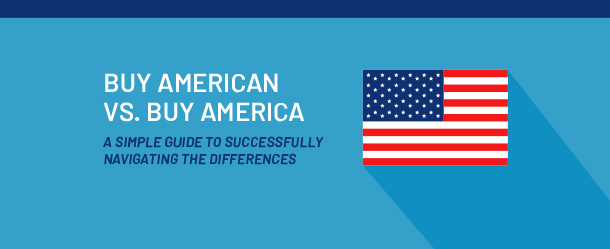



Although they may sound similar, the “Buy American Act” and the “Buy America Act” are very different. Since the early 1930s, the federal government has enforced domestic material procurement requirements when it funds the construction of public projects. Knowing the difference can save your project, as the penalties for failing to comply can be severe.
The Buy American Act was passed by Congress in 1933 under President Herbert Hoover, who signed the legislation on his last day in office. This program covers specified products and requires the U.S. government to purchase domestic construction materials. The Buy American Act created a national preference for the government to procure only domestic materials used for public construction unless a waiver had been granted. The 1933 Act applies to direct purchases by the federal government, but not third parties, such as private contractors given procurement funding through government endowments.
The Buy America Act was established within Section 165 of the Surface Transportation Assistance Act of 1982, which was a transportation funding and policy act created under the Reagan administration. This provision was created to address concerns over the surface transportation of highways and bridges. The Buy America Act was intended to give preference for the use of domestically produced materials on any procurements funded at least in part by the federal government.
The Buy American Act applies when the federal government is directly assisting the procurement of products or a federal facility is being constructed. Under this statute, the goods or products are qualified as being domestic when they are 100% manufactured in the United States and with at least 50% domestic content.
The Buy America Act typically applies only to mass-transit procurements for state and local government projects, such as the construction of highways, railways, or rapid transit systems. The requirements of this statue are regulated by the Federal Transit Administration (FTA), previously known as the Urban Mass Transportation Administration, and the Federal Highway Administration (FHWA).
FHWA was formed in 1967 to oversee federal funding used for construction and the maintenance of National Highway Systems. Under the Buy America Act, end products must be 100% manufactured in the United States and all steel and iron components MUST be mined, melted, and manufactured in the United States. However, there is one important exception; foreign-sourced materials may be allowed if they are valued at $2,500 or 0.1% (whichever is greater) of the contract value. This is referred to as the minimal use amount.
The Buy American Act is less expensive and much easier to comply with than the Buy America Act.
When it comes to the Buy American Act, there are several conditions in which waivers can be issued based upon public interest, unavailability, or costliness. The president and agency heads usually have the authority to waive Buy American requirements if the products or materials are not in the public interest or unavailable in the U.S. in enough quantity and of acceptable quality. The heads of agencies can also be allowed to buy foreign materials or products if their cost would be at least 6-12% lower than the comparable U.S. products.
Waivers of the Buy America Act requirements are less likely to occur but may also be granted on a project-by-project basis if the applications of the provisions are inconsistent with public interest or the steel and/or iron are not produced in the U.S. in enough quantities and of acceptable quality. FHWA regulations also waive Buy America when alternate bidding procedures are used and the lowest overall total bid on using domestic steel is 25% more than the lowest overall total bid based on using foreign steel.
If the minimal use amount (the greater amount of $2,500 or 0.1% of original contract value) has been exceeded, FHWA will review the states material certification procedures for determining Buy America compliance, degree of diligence by the State DOT and contracting agency in ensuring Buy America compliance, contract provisions, availability of domestic iron and steel products, and issues related to removal and replacement with domestic iron and steel products during construction completion.
Once thoroughly investigated, FHWA will provide directions for ratifying the compliance issues. These corrective actions may include the removal of excess foreign iron and steel products and replacement with domestically sourced comparable products or making the non-compliant products Federal-aid non-participating. If there is clear evidence of gross negligence on the part of the contracting agency, FHWA may determine that all project costs are ineligible and all federal funding may be removed from the project.
In summary, it’s difficult for all project stakeholders to understand, or even know, there is a difference between the “Buy American Act” and the “Buy America Act” and it certainly doesn’t help they sound similar in conversation. As owner’s representatives, it is vital for MBP to know and understand which domestic preference rules apply to any of our projects, the compliance certification process for the use of domestic construction materials, and to create compliance processes through training, recordkeeping, and audits. As federal procurement requirements change in the construction industry it is important that we keep ourselves informed and in turn keep our clients informed by making sure these provisions are clearly defined in the construction documents and instructors to bidders.
Comments